MBA402 Risk Assessment Report: Evaluating Trading.com Operations
VerifiedAdded on 2022/11/26
|11
|2804
|497
Report
AI Summary
This report provides a comprehensive risk assessment of Trading.com, a company offering educational seminars and investment mentoring. The analysis utilizes the Risk Exposure Calculator (REC) to identify and evaluate various risks impacting the company's operations. The report examines growth-related risks, including pressure for performance, the rate of expansion, and the inexperience of key employees. It also assesses organizational culture-related risks, such as rewards for entrepreneurial risk-taking, executive resistance to bad news, and the level of internal competition. Furthermore, the report delves into risks associated with information handling, including transaction complexity and velocity, gaps in diagnostic performance, and the degree of decentralized decision-making. Based on the REC score of 42, the report concludes that Trading.com operates in a dangerous zone. The report provides recommendations to mitigate these risks, including implementing policies for fair employee compensation, increasing employment standards, fostering a positive work environment, promoting open communication, and decentralizing decision-making. The report emphasizes the importance of addressing these issues to ensure the company's sustainable growth and success.
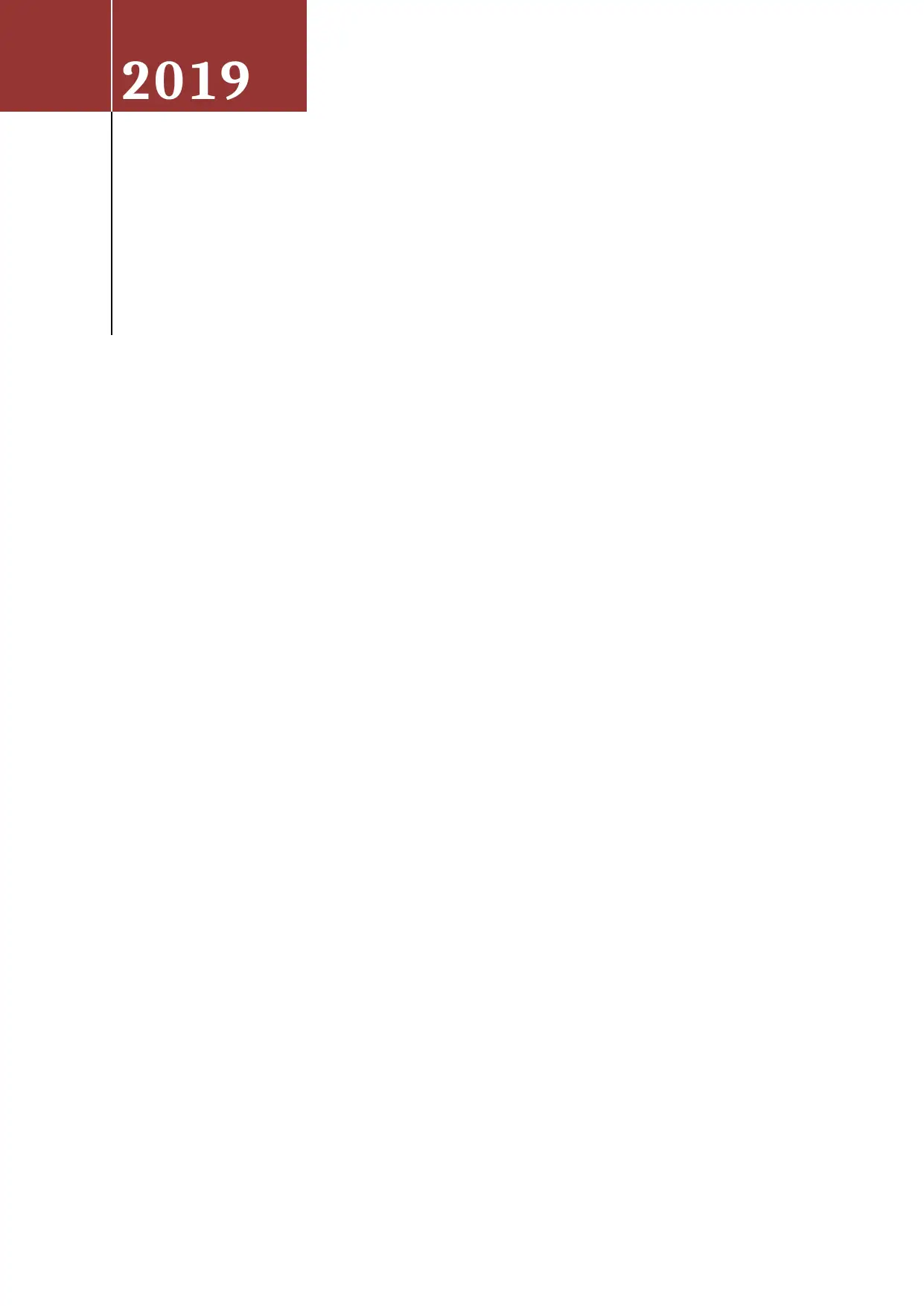
2019
Paraphrase This Document
Need a fresh take? Get an instant paraphrase of this document with our AI Paraphraser
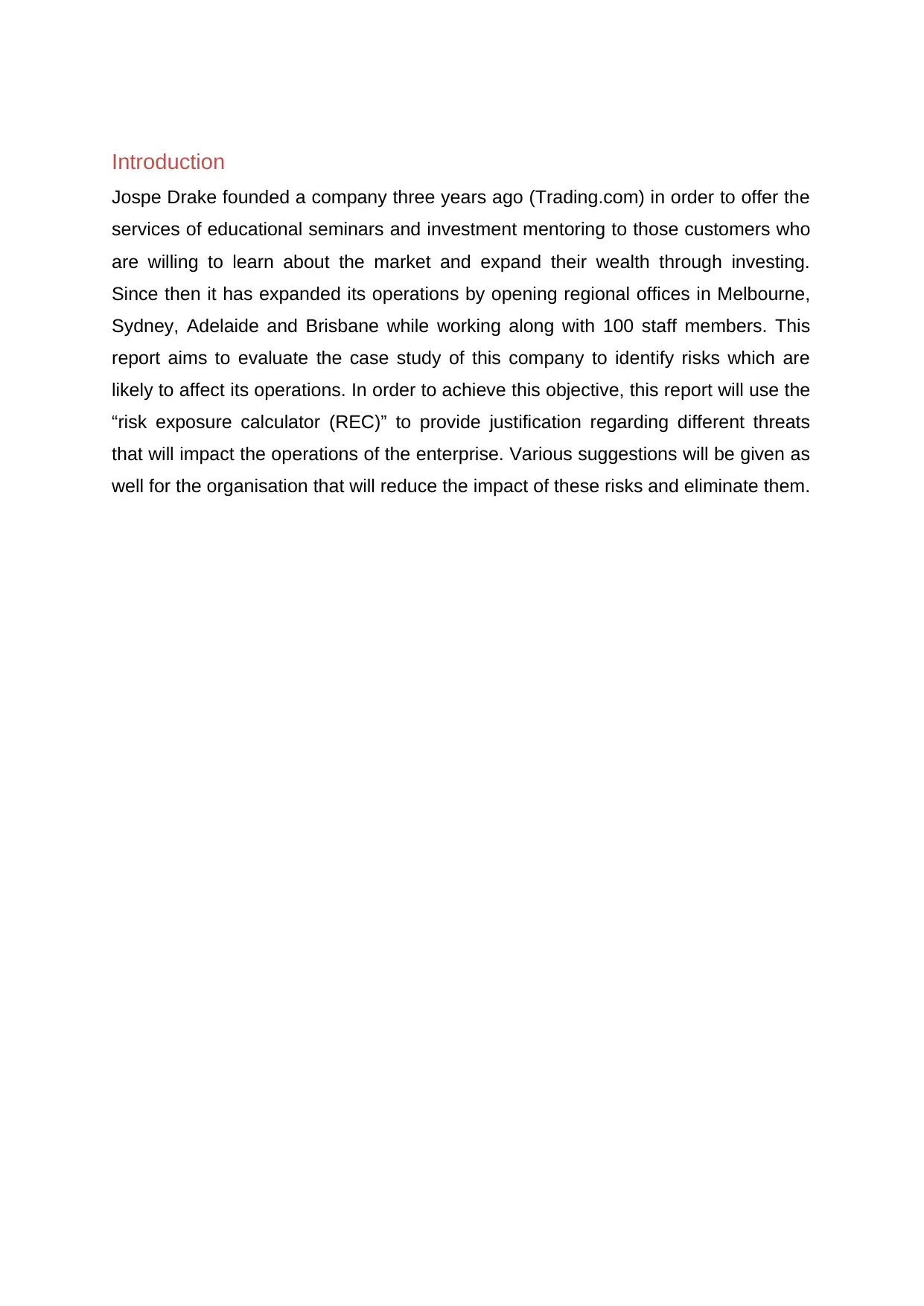
Introduction
Jospe Drake founded a company three years ago (Trading.com) in order to offer the
services of educational seminars and investment mentoring to those customers who
are willing to learn about the market and expand their wealth through investing.
Since then it has expanded its operations by opening regional offices in Melbourne,
Sydney, Adelaide and Brisbane while working along with 100 staff members. This
report aims to evaluate the case study of this company to identify risks which are
likely to affect its operations. In order to achieve this objective, this report will use the
“risk exposure calculator (REC)” to provide justification regarding different threats
that will impact the operations of the enterprise. Various suggestions will be given as
well for the organisation that will reduce the impact of these risks and eliminate them.
Jospe Drake founded a company three years ago (Trading.com) in order to offer the
services of educational seminars and investment mentoring to those customers who
are willing to learn about the market and expand their wealth through investing.
Since then it has expanded its operations by opening regional offices in Melbourne,
Sydney, Adelaide and Brisbane while working along with 100 staff members. This
report aims to evaluate the case study of this company to identify risks which are
likely to affect its operations. In order to achieve this objective, this report will use the
“risk exposure calculator (REC)” to provide justification regarding different threats
that will impact the operations of the enterprise. Various suggestions will be given as
well for the organisation that will reduce the impact of these risks and eliminate them.
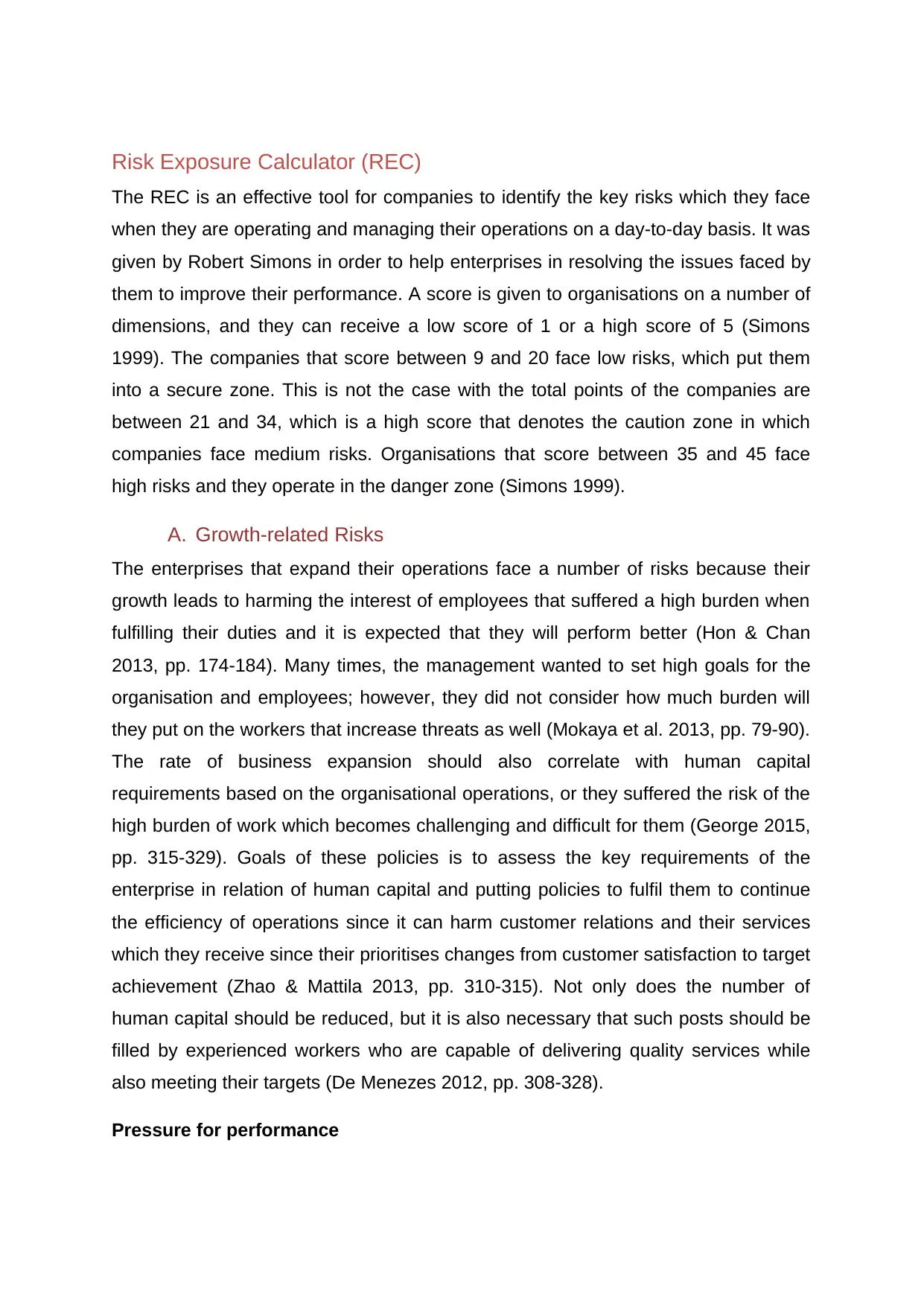
Risk Exposure Calculator (REC)
The REC is an effective tool for companies to identify the key risks which they face
when they are operating and managing their operations on a day-to-day basis. It was
given by Robert Simons in order to help enterprises in resolving the issues faced by
them to improve their performance. A score is given to organisations on a number of
dimensions, and they can receive a low score of 1 or a high score of 5 (Simons
1999). The companies that score between 9 and 20 face low risks, which put them
into a secure zone. This is not the case with the total points of the companies are
between 21 and 34, which is a high score that denotes the caution zone in which
companies face medium risks. Organisations that score between 35 and 45 face
high risks and they operate in the danger zone (Simons 1999).
A. Growth-related Risks
The enterprises that expand their operations face a number of risks because their
growth leads to harming the interest of employees that suffered a high burden when
fulfilling their duties and it is expected that they will perform better (Hon & Chan
2013, pp. 174-184). Many times, the management wanted to set high goals for the
organisation and employees; however, they did not consider how much burden will
they put on the workers that increase threats as well (Mokaya et al. 2013, pp. 79-90).
The rate of business expansion should also correlate with human capital
requirements based on the organisational operations, or they suffered the risk of the
high burden of work which becomes challenging and difficult for them (George 2015,
pp. 315-329). Goals of these policies is to assess the key requirements of the
enterprise in relation of human capital and putting policies to fulfil them to continue
the efficiency of operations since it can harm customer relations and their services
which they receive since their prioritises changes from customer satisfaction to target
achievement (Zhao & Mattila 2013, pp. 310-315). Not only does the number of
human capital should be reduced, but it is also necessary that such posts should be
filled by experienced workers who are capable of delivering quality services while
also meeting their targets (De Menezes 2012, pp. 308-328).
Pressure for performance
The REC is an effective tool for companies to identify the key risks which they face
when they are operating and managing their operations on a day-to-day basis. It was
given by Robert Simons in order to help enterprises in resolving the issues faced by
them to improve their performance. A score is given to organisations on a number of
dimensions, and they can receive a low score of 1 or a high score of 5 (Simons
1999). The companies that score between 9 and 20 face low risks, which put them
into a secure zone. This is not the case with the total points of the companies are
between 21 and 34, which is a high score that denotes the caution zone in which
companies face medium risks. Organisations that score between 35 and 45 face
high risks and they operate in the danger zone (Simons 1999).
A. Growth-related Risks
The enterprises that expand their operations face a number of risks because their
growth leads to harming the interest of employees that suffered a high burden when
fulfilling their duties and it is expected that they will perform better (Hon & Chan
2013, pp. 174-184). Many times, the management wanted to set high goals for the
organisation and employees; however, they did not consider how much burden will
they put on the workers that increase threats as well (Mokaya et al. 2013, pp. 79-90).
The rate of business expansion should also correlate with human capital
requirements based on the organisational operations, or they suffered the risk of the
high burden of work which becomes challenging and difficult for them (George 2015,
pp. 315-329). Goals of these policies is to assess the key requirements of the
enterprise in relation of human capital and putting policies to fulfil them to continue
the efficiency of operations since it can harm customer relations and their services
which they receive since their prioritises changes from customer satisfaction to target
achievement (Zhao & Mattila 2013, pp. 310-315). Not only does the number of
human capital should be reduced, but it is also necessary that such posts should be
filled by experienced workers who are capable of delivering quality services while
also meeting their targets (De Menezes 2012, pp. 308-328).
Pressure for performance
⊘ This is a preview!⊘
Do you want full access?
Subscribe today to unlock all pages.

Trusted by 1+ million students worldwide
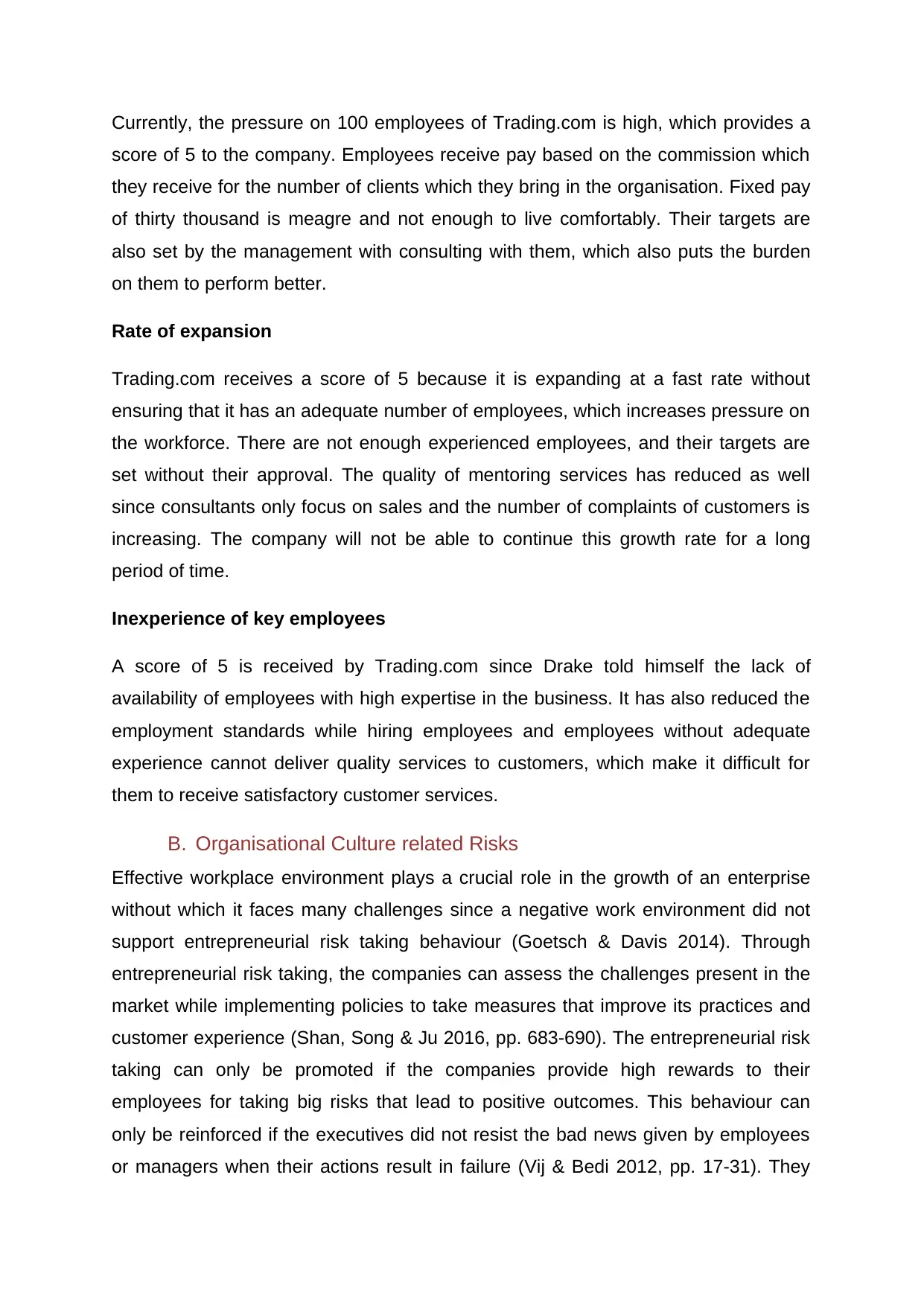
Currently, the pressure on 100 employees of Trading.com is high, which provides a
score of 5 to the company. Employees receive pay based on the commission which
they receive for the number of clients which they bring in the organisation. Fixed pay
of thirty thousand is meagre and not enough to live comfortably. Their targets are
also set by the management with consulting with them, which also puts the burden
on them to perform better.
Rate of expansion
Trading.com receives a score of 5 because it is expanding at a fast rate without
ensuring that it has an adequate number of employees, which increases pressure on
the workforce. There are not enough experienced employees, and their targets are
set without their approval. The quality of mentoring services has reduced as well
since consultants only focus on sales and the number of complaints of customers is
increasing. The company will not be able to continue this growth rate for a long
period of time.
Inexperience of key employees
A score of 5 is received by Trading.com since Drake told himself the lack of
availability of employees with high expertise in the business. It has also reduced the
employment standards while hiring employees and employees without adequate
experience cannot deliver quality services to customers, which make it difficult for
them to receive satisfactory customer services.
B. Organisational Culture related Risks
Effective workplace environment plays a crucial role in the growth of an enterprise
without which it faces many challenges since a negative work environment did not
support entrepreneurial risk taking behaviour (Goetsch & Davis 2014). Through
entrepreneurial risk taking, the companies can assess the challenges present in the
market while implementing policies to take measures that improve its practices and
customer experience (Shan, Song & Ju 2016, pp. 683-690). The entrepreneurial risk
taking can only be promoted if the companies provide high rewards to their
employees for taking big risks that lead to positive outcomes. This behaviour can
only be reinforced if the executives did not resist the bad news given by employees
or managers when their actions result in failure (Vij & Bedi 2012, pp. 17-31). They
score of 5 to the company. Employees receive pay based on the commission which
they receive for the number of clients which they bring in the organisation. Fixed pay
of thirty thousand is meagre and not enough to live comfortably. Their targets are
also set by the management with consulting with them, which also puts the burden
on them to perform better.
Rate of expansion
Trading.com receives a score of 5 because it is expanding at a fast rate without
ensuring that it has an adequate number of employees, which increases pressure on
the workforce. There are not enough experienced employees, and their targets are
set without their approval. The quality of mentoring services has reduced as well
since consultants only focus on sales and the number of complaints of customers is
increasing. The company will not be able to continue this growth rate for a long
period of time.
Inexperience of key employees
A score of 5 is received by Trading.com since Drake told himself the lack of
availability of employees with high expertise in the business. It has also reduced the
employment standards while hiring employees and employees without adequate
experience cannot deliver quality services to customers, which make it difficult for
them to receive satisfactory customer services.
B. Organisational Culture related Risks
Effective workplace environment plays a crucial role in the growth of an enterprise
without which it faces many challenges since a negative work environment did not
support entrepreneurial risk taking behaviour (Goetsch & Davis 2014). Through
entrepreneurial risk taking, the companies can assess the challenges present in the
market while implementing policies to take measures that improve its practices and
customer experience (Shan, Song & Ju 2016, pp. 683-690). The entrepreneurial risk
taking can only be promoted if the companies provide high rewards to their
employees for taking big risks that lead to positive outcomes. This behaviour can
only be reinforced if the executives did not resist the bad news given by employees
or managers when their actions result in failure (Vij & Bedi 2012, pp. 17-31). They
Paraphrase This Document
Need a fresh take? Get an instant paraphrase of this document with our AI Paraphraser

should promote them to continue taking risks rather than avoiding their constructive
criticism. The level of internal competition has an effect on the company’s growth in
both positive and negative aspects (Holbeche 2012). This factor is crucial to be
considered since ruthlessness in the culture harms the performance of workers, and
it is also bad for customer services since employees only focus on achieving their
targets rather than providing quality services to customers (Theodosiou, Kehagias &
Katsikea 2012, pp. 1058-1070).
Entrepreneurial risk taking rewards
The policies which are targeted towards promoting the risk taking the attitude of
employees for entrepreneurial risks are not present; thus, Trading.com receives a
score of 4. Rewards are only given for sales targets, and the management did not
consider their risk taking attitude or quality of service delivery, which only increases
competition in the organisation rather than the improvement of its operations. The
risks taken by the senior management team are failing since consultation not made
with local management or employees regarding the formation of courses which
caters to the demand of customers.
Bad news resistance
This element creates a major risk for the enterprise since the local management’s
decisions are affected by people who only say “yes” due to which they did not hear
bad news; thus, it receives a score of 5. Regional managers did not allow the
employees to provide their criticism regarding the operations of the company. There
is no interaction that is crucial to avoid resistance of bad news between the top and
low-level management, especially in the case when business strategies are being
formed.
Internal competition intensity
In this aspect, Trading.com has failed as well, and it receives a score of 5 since the
internal competition is fierce in the company. Ruthlessness has become common in
the workplace, which is used to promote the achievement of targets relating to
customers. Employees are only judged on their sales performance for which they
receive expensive rewards, and they are also pitted against each other that create a
negative work culture. It also shifts the focus on employees from customers since
criticism. The level of internal competition has an effect on the company’s growth in
both positive and negative aspects (Holbeche 2012). This factor is crucial to be
considered since ruthlessness in the culture harms the performance of workers, and
it is also bad for customer services since employees only focus on achieving their
targets rather than providing quality services to customers (Theodosiou, Kehagias &
Katsikea 2012, pp. 1058-1070).
Entrepreneurial risk taking rewards
The policies which are targeted towards promoting the risk taking the attitude of
employees for entrepreneurial risks are not present; thus, Trading.com receives a
score of 4. Rewards are only given for sales targets, and the management did not
consider their risk taking attitude or quality of service delivery, which only increases
competition in the organisation rather than the improvement of its operations. The
risks taken by the senior management team are failing since consultation not made
with local management or employees regarding the formation of courses which
caters to the demand of customers.
Bad news resistance
This element creates a major risk for the enterprise since the local management’s
decisions are affected by people who only say “yes” due to which they did not hear
bad news; thus, it receives a score of 5. Regional managers did not allow the
employees to provide their criticism regarding the operations of the company. There
is no interaction that is crucial to avoid resistance of bad news between the top and
low-level management, especially in the case when business strategies are being
formed.
Internal competition intensity
In this aspect, Trading.com has failed as well, and it receives a score of 5 since the
internal competition is fierce in the company. Ruthlessness has become common in
the workplace, which is used to promote the achievement of targets relating to
customers. Employees are only judged on their sales performance for which they
receive expensive rewards, and they are also pitted against each other that create a
negative work culture. It also shifts the focus on employees from customers since
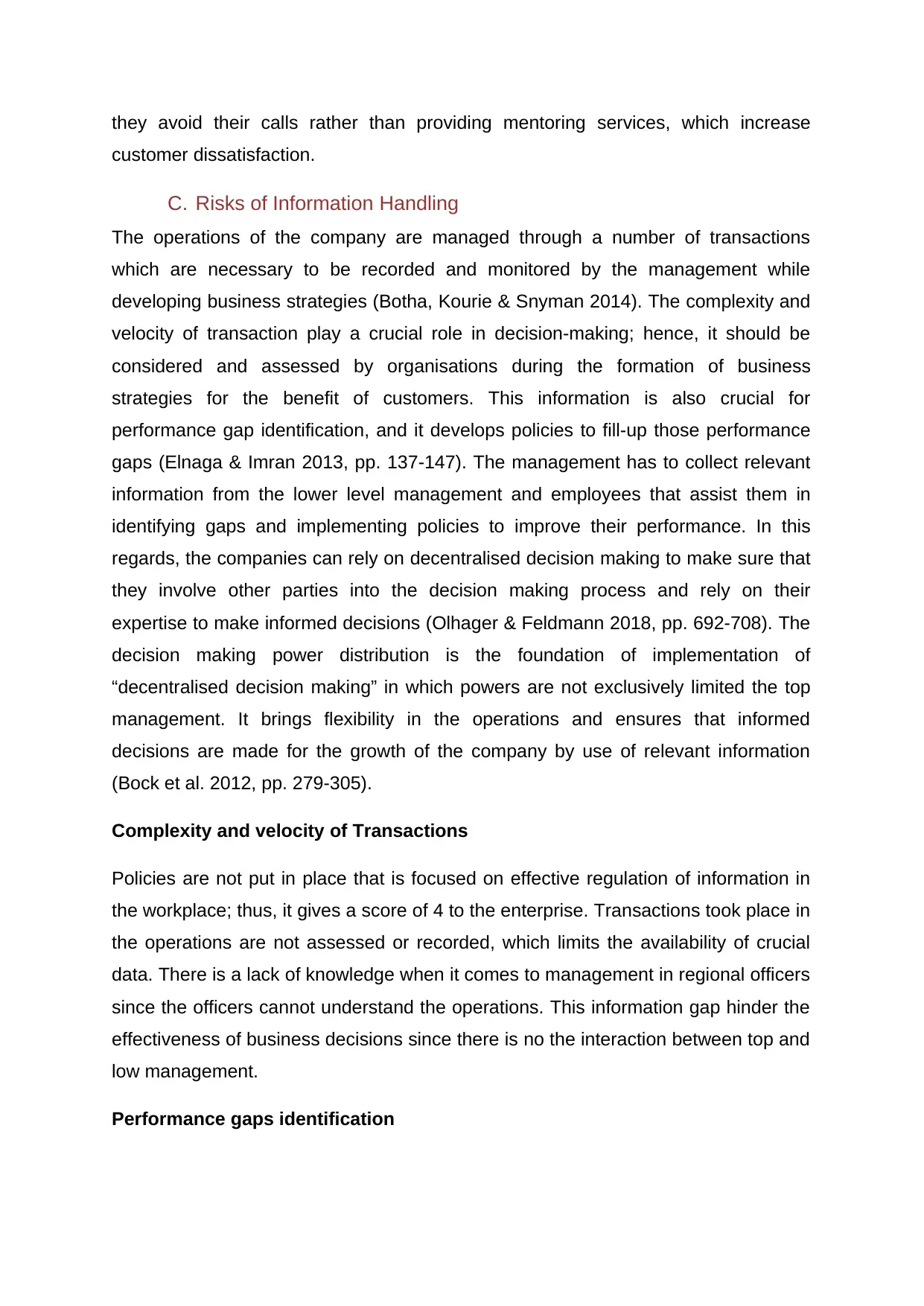
they avoid their calls rather than providing mentoring services, which increase
customer dissatisfaction.
C. Risks of Information Handling
The operations of the company are managed through a number of transactions
which are necessary to be recorded and monitored by the management while
developing business strategies (Botha, Kourie & Snyman 2014). The complexity and
velocity of transaction play a crucial role in decision-making; hence, it should be
considered and assessed by organisations during the formation of business
strategies for the benefit of customers. This information is also crucial for
performance gap identification, and it develops policies to fill-up those performance
gaps (Elnaga & Imran 2013, pp. 137-147). The management has to collect relevant
information from the lower level management and employees that assist them in
identifying gaps and implementing policies to improve their performance. In this
regards, the companies can rely on decentralised decision making to make sure that
they involve other parties into the decision making process and rely on their
expertise to make informed decisions (Olhager & Feldmann 2018, pp. 692-708). The
decision making power distribution is the foundation of implementation of
“decentralised decision making” in which powers are not exclusively limited the top
management. It brings flexibility in the operations and ensures that informed
decisions are made for the growth of the company by use of relevant information
(Bock et al. 2012, pp. 279-305).
Complexity and velocity of Transactions
Policies are not put in place that is focused on effective regulation of information in
the workplace; thus, it gives a score of 4 to the enterprise. Transactions took place in
the operations are not assessed or recorded, which limits the availability of crucial
data. There is a lack of knowledge when it comes to management in regional officers
since the officers cannot understand the operations. This information gap hinder the
effectiveness of business decisions since there is no the interaction between top and
low management.
Performance gaps identification
customer dissatisfaction.
C. Risks of Information Handling
The operations of the company are managed through a number of transactions
which are necessary to be recorded and monitored by the management while
developing business strategies (Botha, Kourie & Snyman 2014). The complexity and
velocity of transaction play a crucial role in decision-making; hence, it should be
considered and assessed by organisations during the formation of business
strategies for the benefit of customers. This information is also crucial for
performance gap identification, and it develops policies to fill-up those performance
gaps (Elnaga & Imran 2013, pp. 137-147). The management has to collect relevant
information from the lower level management and employees that assist them in
identifying gaps and implementing policies to improve their performance. In this
regards, the companies can rely on decentralised decision making to make sure that
they involve other parties into the decision making process and rely on their
expertise to make informed decisions (Olhager & Feldmann 2018, pp. 692-708). The
decision making power distribution is the foundation of implementation of
“decentralised decision making” in which powers are not exclusively limited the top
management. It brings flexibility in the operations and ensures that informed
decisions are made for the growth of the company by use of relevant information
(Bock et al. 2012, pp. 279-305).
Complexity and velocity of Transactions
Policies are not put in place that is focused on effective regulation of information in
the workplace; thus, it gives a score of 4 to the enterprise. Transactions took place in
the operations are not assessed or recorded, which limits the availability of crucial
data. There is a lack of knowledge when it comes to management in regional officers
since the officers cannot understand the operations. This information gap hinder the
effectiveness of business decisions since there is no the interaction between top and
low management.
Performance gaps identification
⊘ This is a preview!⊘
Do you want full access?
Subscribe today to unlock all pages.

Trusted by 1+ million students worldwide

Trading.com has failed in this aspect as well with a score of 4 since there is a lack of
policies that identify the limitations in its operations. Sales figures are the only source
which the senior executive team has to identify the performance gaps of consultants.
The key issue with them is that many times, they are not delivered on time or at all.
Consumer feedback and evaluation of their complaints are not made that limits the
access of information resulted in reducing the quality of decisions.
Decentralised decision making
Due to implementation of a centralised decision making system, Trading.com scores
5 points. The power is only limited to the executive team, and they did not consult
with others or collect their feedback while taking business decisions. The regional
managers have no powers of decision making, and employees are not consulted
when decisions are made.
policies that identify the limitations in its operations. Sales figures are the only source
which the senior executive team has to identify the performance gaps of consultants.
The key issue with them is that many times, they are not delivered on time or at all.
Consumer feedback and evaluation of their complaints are not made that limits the
access of information resulted in reducing the quality of decisions.
Decentralised decision making
Due to implementation of a centralised decision making system, Trading.com scores
5 points. The power is only limited to the executive team, and they did not consult
with others or collect their feedback while taking business decisions. The regional
managers have no powers of decision making, and employees are not consulted
when decisions are made.
Paraphrase This Document
Need a fresh take? Get an instant paraphrase of this document with our AI Paraphraser

Conclusion
Figure 1: REC score
(Source: By Author)
The use of REC can be beneficial for organisations in identifying their position by
evaluating their risks. After totalling the score on the REC, it can be analysed that a
high score is received by Trading.com (42) that puts it at a dangerous position.
Immediate actions should be put in place for removal of these threats or else it could
face challenges which could harm the growth of the enterprise.
Recommendations
Since the score received in the REC is considerably high, suggestions are given
below for addressing these challenges by taking strategic decisions. One of the key
threats is high employee pressure which can be reduced once appropriate policies
are put in place by the enterprise for a fixed salary that is enough for living a
comfortable life even if they make less commission through sales. The employment
standards of the company should be increased so that it hires experienced
employees to manage its operations. Both of these steps will result in reducing the
Figure 1: REC score
(Source: By Author)
The use of REC can be beneficial for organisations in identifying their position by
evaluating their risks. After totalling the score on the REC, it can be analysed that a
high score is received by Trading.com (42) that puts it at a dangerous position.
Immediate actions should be put in place for removal of these threats or else it could
face challenges which could harm the growth of the enterprise.
Recommendations
Since the score received in the REC is considerably high, suggestions are given
below for addressing these challenges by taking strategic decisions. One of the key
threats is high employee pressure which can be reduced once appropriate policies
are put in place by the enterprise for a fixed salary that is enough for living a
comfortable life even if they make less commission through sales. The employment
standards of the company should be increased so that it hires experienced
employees to manage its operations. Both of these steps will result in reducing the

pressure faced by current employees, and it will also assist them in ensuring that
customers receive satisfactory mentoring services from the consultants. The ruthless
nature of employees as a result of high competition should be addressed as well.
This issue can be addressed once customer satisfaction is given more priority rather
than sales figures and rewards will only be given to those employees that put high
stakes for entrepreneurial risks. The executives should not resist bad news; instead,
they should encourage employees, even when they fail, to try again and also provide
their constructive criticism on the operations of the company. Managers have to
ensure that employees are not compared with others based on their sales
performance, and interactions between them are achieved to improve the decision
making process. The decision making framework of the company should be
decentralised in which power to take decisions should be given to regional managers
and employees should also be consulted when decisions are being taken. It will
allow the senior management team to take decisions regarding courses that will
succeed between customers, and it will provide a competitive edge to the
organisation.
customers receive satisfactory mentoring services from the consultants. The ruthless
nature of employees as a result of high competition should be addressed as well.
This issue can be addressed once customer satisfaction is given more priority rather
than sales figures and rewards will only be given to those employees that put high
stakes for entrepreneurial risks. The executives should not resist bad news; instead,
they should encourage employees, even when they fail, to try again and also provide
their constructive criticism on the operations of the company. Managers have to
ensure that employees are not compared with others based on their sales
performance, and interactions between them are achieved to improve the decision
making process. The decision making framework of the company should be
decentralised in which power to take decisions should be given to regional managers
and employees should also be consulted when decisions are being taken. It will
allow the senior management team to take decisions regarding courses that will
succeed between customers, and it will provide a competitive edge to the
organisation.
⊘ This is a preview!⊘
Do you want full access?
Subscribe today to unlock all pages.

Trusted by 1+ million students worldwide
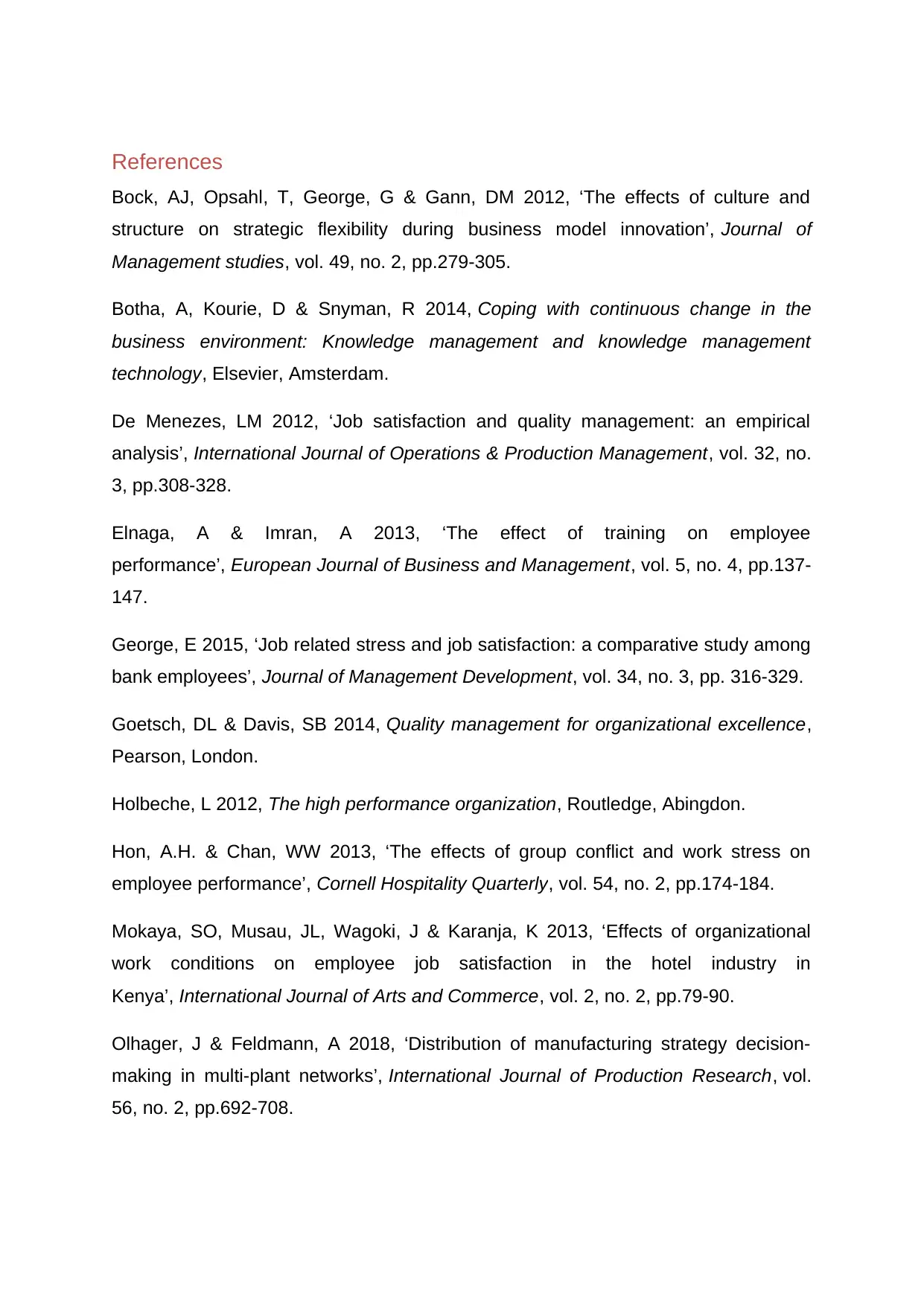
References
Bock, AJ, Opsahl, T, George, G & Gann, DM 2012, ‘The effects of culture and
structure on strategic flexibility during business model innovation’, Journal of
Management studies, vol. 49, no. 2, pp.279-305.
Botha, A, Kourie, D & Snyman, R 2014, Coping with continuous change in the
business environment: Knowledge management and knowledge management
technology, Elsevier, Amsterdam.
De Menezes, LM 2012, ‘Job satisfaction and quality management: an empirical
analysis’, International Journal of Operations & Production Management, vol. 32, no.
3, pp.308-328.
Elnaga, A & Imran, A 2013, ‘The effect of training on employee
performance’, European Journal of Business and Management, vol. 5, no. 4, pp.137-
147.
George, E 2015, ‘Job related stress and job satisfaction: a comparative study among
bank employees’, Journal of Management Development, vol. 34, no. 3, pp. 316-329.
Goetsch, DL & Davis, SB 2014, Quality management for organizational excellence,
Pearson, London.
Holbeche, L 2012, The high performance organization, Routledge, Abingdon.
Hon, A.H. & Chan, WW 2013, ‘The effects of group conflict and work stress on
employee performance’, Cornell Hospitality Quarterly, vol. 54, no. 2, pp.174-184.
Mokaya, SO, Musau, JL, Wagoki, J & Karanja, K 2013, ‘Effects of organizational
work conditions on employee job satisfaction in the hotel industry in
Kenya’, International Journal of Arts and Commerce, vol. 2, no. 2, pp.79-90.
Olhager, J & Feldmann, A 2018, ‘Distribution of manufacturing strategy decision-
making in multi-plant networks’, International Journal of Production Research, vol.
56, no. 2, pp.692-708.
Bock, AJ, Opsahl, T, George, G & Gann, DM 2012, ‘The effects of culture and
structure on strategic flexibility during business model innovation’, Journal of
Management studies, vol. 49, no. 2, pp.279-305.
Botha, A, Kourie, D & Snyman, R 2014, Coping with continuous change in the
business environment: Knowledge management and knowledge management
technology, Elsevier, Amsterdam.
De Menezes, LM 2012, ‘Job satisfaction and quality management: an empirical
analysis’, International Journal of Operations & Production Management, vol. 32, no.
3, pp.308-328.
Elnaga, A & Imran, A 2013, ‘The effect of training on employee
performance’, European Journal of Business and Management, vol. 5, no. 4, pp.137-
147.
George, E 2015, ‘Job related stress and job satisfaction: a comparative study among
bank employees’, Journal of Management Development, vol. 34, no. 3, pp. 316-329.
Goetsch, DL & Davis, SB 2014, Quality management for organizational excellence,
Pearson, London.
Holbeche, L 2012, The high performance organization, Routledge, Abingdon.
Hon, A.H. & Chan, WW 2013, ‘The effects of group conflict and work stress on
employee performance’, Cornell Hospitality Quarterly, vol. 54, no. 2, pp.174-184.
Mokaya, SO, Musau, JL, Wagoki, J & Karanja, K 2013, ‘Effects of organizational
work conditions on employee job satisfaction in the hotel industry in
Kenya’, International Journal of Arts and Commerce, vol. 2, no. 2, pp.79-90.
Olhager, J & Feldmann, A 2018, ‘Distribution of manufacturing strategy decision-
making in multi-plant networks’, International Journal of Production Research, vol.
56, no. 2, pp.692-708.
Paraphrase This Document
Need a fresh take? Get an instant paraphrase of this document with our AI Paraphraser

Shan, P, Song, M & Ju, X 2016, ‘Entrepreneurial orientation and performance: Is
innovation speed a missing link?’, Journal of Business Research, vol. 69, no. 2,
pp.683-690.
Simons, R 1999, How Risky Is Your Company?, HBR, viewed 20 May 2019, <
https://hbr.org/1999/05/how-risky-is-your-company>.
Theodosiou, M, Kehagias, J & Katsikea, E 2012, ‘Strategic orientations, marketing
capabilities and firm performance: An empirical investigation in the context of
frontline managers in service organizations’, Industrial Marketing Management, vol.
41, no. 7, pp.1058-1070.
Vij, S & Bedi, HS 2012, ‘Relationship between entrepreneurial orientation and
business performance: A review of literature’, The IUP Journal of Business Strategy,
vol. 9, no. 3, pp.17-31.
Zhao, XR & Mattila, AS 2013, ‘Examining the spillover effect of frontline employees’
work–family conflict on their affective work attitudes and customer
satisfaction’, International Journal of Hospitality Management, vol. 33, pp.310-315.
innovation speed a missing link?’, Journal of Business Research, vol. 69, no. 2,
pp.683-690.
Simons, R 1999, How Risky Is Your Company?, HBR, viewed 20 May 2019, <
https://hbr.org/1999/05/how-risky-is-your-company>.
Theodosiou, M, Kehagias, J & Katsikea, E 2012, ‘Strategic orientations, marketing
capabilities and firm performance: An empirical investigation in the context of
frontline managers in service organizations’, Industrial Marketing Management, vol.
41, no. 7, pp.1058-1070.
Vij, S & Bedi, HS 2012, ‘Relationship between entrepreneurial orientation and
business performance: A review of literature’, The IUP Journal of Business Strategy,
vol. 9, no. 3, pp.17-31.
Zhao, XR & Mattila, AS 2013, ‘Examining the spillover effect of frontline employees’
work–family conflict on their affective work attitudes and customer
satisfaction’, International Journal of Hospitality Management, vol. 33, pp.310-315.
1 out of 11
Related Documents
Your All-in-One AI-Powered Toolkit for Academic Success.
+13062052269
info@desklib.com
Available 24*7 on WhatsApp / Email
![[object Object]](/_next/static/media/star-bottom.7253800d.svg)
Unlock your academic potential
Copyright © 2020–2025 A2Z Services. All Rights Reserved. Developed and managed by ZUCOL.





